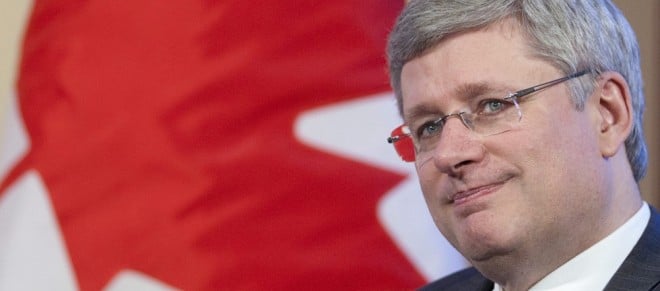Health spending: what Harper said, and the real outlook
Harper’s declaration that the federal contribution will outstrip provincial spending applies only to the very short term
Prime Minister Stephen Harper is seen during a meeting with Catherine Swift, President and CEO of the Canadian Federation of Independent Business, at his office in Ottawa Wednesday January 18, 2012. THE CANADIAN PRESS/Adrian Wyld
Share
 The Prime Minister gave us plenty to mull over in his interview this week with CBC’s Peter Mansbridge—on oil pipelines, the Iranian nuclear threat, public service pensions—but the line that popped out for me was Stephen Harper’s surprising claim about the generosity of federal health transfers to the provinces.
The Prime Minister gave us plenty to mull over in his interview this week with CBC’s Peter Mansbridge—on oil pipelines, the Iranian nuclear threat, public service pensions—but the line that popped out for me was Stephen Harper’s surprising claim about the generosity of federal health transfers to the provinces.
His boast sounded precise. Asked by Mansbridge about the premiers wanting more money than the take-it-or-leave-it offer Finance Minister Jim Flaherty recently put on the table, Harper said: “In fact, our transfers on health care, according to projections, are going to grow more quickly than provincial spending on health care.”
If this were true, it would amount to an all but irrefutable rebuttal to anyone who argues the Conservative government isn’t doing its bit to shore up the health system. If Ottawa is on track to increase its share of health funding, then the provinces can hardly complain.
But I haven’t seen any forecast suggesting this is the case. So I asked the Prime Minister’s Office exactly what projections Harper was alluding to. The PMO said he was referring–not to any study of the health spending outlook—but to short-term plans contained in recent provincial budget updates.
Most provinces don’t make terribly useful projections in this area. Those that offer any numbers—notably Nova Scotia, Quebec, Ontario and Alberta—don’t look out beyond the next two or three years. It’s accurate, for what it’s worth, to say that their planned health spending growth for the next few years falls below the six-per-cent annual increase in the Canada Health Transfer that Flaherty promises to keep up until 2016-17.
In that very limited timeframe then, the Prime Minister has a point. But I think a reasonable listener hearing him declare that the federal contribution will outstrip provincial spending wouldn’t have imagined he meant only in the very short term.
And longer forecasts, in fact, project a declining federal contribution as a share of provincial health spending. After 2016-17, Flaherty’s plan is for CHT growth to slow from six-per-cent a year to the nominal increase in gross Domestic product, or economic growth plus inflation, which is likely to run somewhere around four per cent. It’s hard to see that keeping pace with the cost of health care.
The Parliamentary Budget Officer last week released “Renewing the Canada Health Transfer: Implications for Federal and Provincial-Territorial Fiscal Sustainability.” The independent PBO projects that growth in federal health transfers will roughly match climbing provincial spending until 2016-7. After that, Ottawa’s payments will rise 3.9 per cent a year on average, which is “significantly lower” than the PBO’s forecast for for provincial health spending to grow 5.1 per cent a year.
According to the PBO, Flaherty’s plan to put the brakes on growth in health transfers goes a long way to stabilizing the federal debt level, measured as a share of the economy. On the other hand, most provinces face the prospect of their debt levels rising—unless they hike taxes or cut spending, or some mix of both.
It’s worth noting that the PBO doesn’t suggest that health costs are mounting to crushing levels. That projection of 5.1 per cent a year growth translates into serious money, no doubt about it, but it’s below historic rates. Since 1975, according to a C.D. Howe Institute report last year, health care spending in Canada has grown on average 8.3 per cent a year.
The real budget crunch comes not from rising health costs alone, but from slowing overall economic growth. The authors of that C.D. Howe study, the estimable David Dodge and Richard Dion, forecast that nominal GDP growth is likely to slow from 4.8 percent between this year and 2016, down to 3.8 percent in the 2020s. The main drag: an aging population, which means a smaller portion of the population working to generate wealth and pay taxes.
Against that backdrop, it seems to me Flaherty’s plan to peg the rise in its health transfers to the economy isn’t unreasonable. Federal transfers will keep pace with less vigorous economic growth, but not with the increasing bite health care will take out of the changed economy. The provinces will have to make up the difference, likely by raising taxes, or offloading some costs by requiring individuals to pay for more health care out of pocket. For my part, I hope the latter option is roundly rejected.
Whatever the policy outcome, though, it makes sense for the level of government that actually manages most care to make those tough calls, as long as the core Canada Health Act principles of universality are respected.
Harper’s remark about projected federal spending shouldn’t mislead anyone into thinking Ottawa’s stake in the coming health care debate is somehow on the rise. What’s really shaping up as an historic test of the ability of provincial politicians to lead on the policy file that arguably matters most to Canadians.